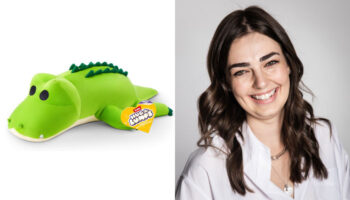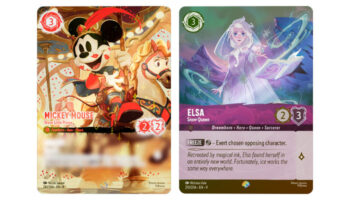Quillsilver Studio’s Brenna Noonan on how a classical music background informs her approach to game design

Brenna Noonan – President at Quillsilver Studio – talks us through the firm’s one-stop-shop offering for game designers and publishers.
Brenna, it’s great to chat. To kick us off, what was your route into the board game industry?
It wasn’t planned – it was a very circuitous route! My background is actually in classical music; I have a Master’s degree in Classical Music Composition. While I was a musician, I taught myself marketing – because I was marketing myself basically – and so throughout school I worked marketing jobs at places like Stanford Jazz Workshop. When I finished grad school, I got a marketing job with the San Jose Sharks in the NHL. It turns out you can make a lot more money doing that than doing classical music!
That’s how I got into marketing, but I’ve always been a huge games fan; I got my first console – a Nintendo 64 – when I was six. While I was working in the NHL, I had it in my mind that I wanted to break into the video games industry. I didn’t really have any in-roads there, and I ended up moving across the country back to New Hampshire to be closer to my family. I was looking for a new job there and I saw a small board game company called Tabletop Tycoon was hiring, and I wound up getting the job – and that’s how I got into the board game industry.
The old ‘classical musical to hockey to board games’ route. We hear it a lot!
Ha! We’ve all been there, right?
I’m interested, does your background in classical music composition steer anything you now do in board games?
I think there are parallels. My composition background gives me a different perspective when approaching game design. In music school, we learn a lot of things about form and structure; harmonies, resonance, dissonance… We all know the term ludonarrative dissonance! I think about all those things as I design, not just how a game plays but the form and structure of a game. Harmonic resonance from a gameplay perspective… These are things I think about a lot.
Properly fascinating stuff. Now, you’re the President of Quillsilver Studio. What led you to set the company up?
I stayed at Tabletop Tycoon for two and a half years, and while I was there, I met my now husband Dann May, who happens to be an extremely talented game developer, artist and art director. We wanted to strike out on our own and do something that was just ours, so we left and set up Quillsilver with Dann’s brother Greg, who is a wonderful 3D artist and graphic designer.
And for anyone new to Quillsilver talk us through some of the services you guys offer.
We launched Quillsilver as a one-stop shop for publishers and designers. Somebody can come to us with a game at any stage of development – it could even be a concept – drop it off with us, and in a few months we’ll come back to them with a completely finished game that’s ready to go to market.
We’ll do the game design, development, art direction, illustration, product design, graphic design, 3D sculpting. We can put it on Kickstarter, we can market it… We can do it all in-house. That’s our pitch to people!
It’s a very compelling one! Can you give any examples of work we might’ve seen that highlights the strengths of the studio?
Everdell is a good example. The success of Everdell was something of a litmus test for Dann and I. That highlighted that when we team up, really good things can happen. It wasn’t a game we designed – Everdell was designed by the wonderful James Wilson – but we developed the game and did the art direction, product design and graphic design. Dann found Andrew Bosley, who illustrated the game, and Dann also themed the game and brought woodland critters into it.

One of our first big projects as a new studio was Birdwood Games’ Dog Park, and that was a really good “proof of concept” for the studio as all three of us got to contribute and we were able to help guide the product design from a fairly early stage. I developed the game, Dann art directed it, partially illustrated it, and did the graphic design, and Greg created the renders for the game as well as the Kickstarter video and the Kickstarter page.

Great stuff. Everdell’s theme feels so organic to that game, it feels strange to think it ever had any other theme!
Yeah! Everdell actually came to us with a medieval village theme. There are some cards that remain the same, like the Farm card – I think James said that was the very first card he designed. We knew we wanted to do something a bit unexpected with the theme, while still feeling very integrated and natural with the mechanics. It was a matter of identifying aspects of the gameplay that suggested unique thematic possibilities
It’s also helpful to remember that at the time we were developing the theme, there was a preponderance of dark themes in games – I think zombies were very popular at the time! So, we wanted to do a more welcoming, pastoral theme.
Everdell is a very eye-catching game – it really looks special with the multi-tiered Ever Tree. With so many games launched every week, how key is it for publishers to use smart art direction to cut through?
We’ve seen a huge shift over the last few years where publishers now pay a lot more attention to the aesthetics of their games. It’s become a lot more important, and that’s why people seek us out as we’re able to do that kind of elevated product design. We can create unusual components that stand out on the table and catch your eye.
The funny thing with Everdell is that it looked so good that people were kind of suspicious of it! They were like: ‘It’s beautiful, but does it play well? Is it just a pretty face?’ That was funny to me because if we’ve taken so much care around how the game looks, of course we take the same amount of care around how the game plays mechanically. People are becoming less suspicious of that now; they understand that games can look beautiful and play beautifully. It doesn’t have to be one or the other.

Do you think it makes business-sense to be braver when it comes to theming games, especially in the wake of success stories like Wingspan?
Yeah, I mean look at Funko Games. They just launched a Rear Window game! It’s a film I love so I’m excited about it, but it’s not a brand I thought would ever be licensed to a tabletop game. It’s cool to see people be more creative with that kind of thing.
As a designer, I think it’s always a difficult line to tread. To some degree, there’s an element of proven success with certain themes. It’s about knowing when to stay in that lane and when to push out and try something new. That’s a hard decision to make and something we take on a game-to-game basis. We try and let the game tell us what it wants to be.
The audience and who you’re designing for also plays a huge role in that decision. Because of my marketing background, I’m always thinking about the end product, who it’s for and how it’ll look on the shelf. At Quillsilver, it’s something we can do well because we have a very holistic process.
Everdell has been a success in the tabletop space. Do you also work in the mass market games industry? Do you have to work differently in this sector?
We do work on mass market games as well. We did the graphic design and some illustration for Eric Lang’s Disney Sidekicks game for Spin Master, for instance. We also worked with Jubilee Media to design the Spectrum card game for them. It’s a mass market party game, and we’re designing a couple of other games in that space too. It’s definitely an area that interests us. The work we do is very much about bridging that gap and making hobby games more accessible, and mass market games more elevated.

There are of course differences with the types of companies we work with – hobby game companies tend to be smaller whereas mass market companies tend to be bigger, which can mean different types of creative collaborations. For mass market games there will generally be a tighter scope especially if there’s a license involved. For example, they may dictate the exact components they want in order to hit the price point they need, and we really can’t deviate from that. But within those constraints we’ll generally have a lot of autonomy to complete the game. With hobby, the creative process tends to be slightly looser and there’s a little more room for creative discoveries and changes of direction.
You mention designing games there. Do you pitch game concepts outside of the services provided by Quillsilver?
Yes, we do a mix of things. We have some internal projects that we’ll be self-publishing, and we have some mass market concepts that we’ll be pitching to larger companies. We also have commissioned designs, like what we did with Jubilee’s Spectrum game, based on their hit YouTube show.
Great. You’re based in Melbourne, Australia. Is there a board game design scene there that you’re involved with?
I’m lucky in that both places I live have thriving board game cultures. I know we tend to think of the big regional hubs, but there are plenty of pockets of board game communities. Back in New Hampshire I’ll shout out my local board game café Boards and Brews. It’s one of the biggest board game cafes in New England and they do amazing game meetups. I’ve met lots of local designers and players through that.
Here in Melbourne, there’s a burgeoning board game community. We actually just went to an in-person board game design jam a few weeks ago. It was great, and a lot of people might not expect that this area could support that, but it absolutely can.
Amazing. Brenna, this has been great. I have one last question: how do you fuel your creativity?
I really thrive with structure and a schedule. That’s what I need. It’s hard sometimes to turn creativity on like a faucet. Some days you just don’t really have it and you have to learn to be okay with that. Luckily, with running a small company there is never any shortage of work to do!
It’s of course important to play games and understand the vernacular of games, but I also think it’s key to do things other than games. I have a lot of hobbies outside of games and different interests, and that helps prevent me getting too burnt out. Other interests like music, film, and literature help to inspire me and really fuel me creatively.
Brenna, this has been great. A huge thanks again for taking the time. And we should mention, anyone interested in connected can do so at http://quillsilver.com/.
–
To stay in the loop with the latest news, interviews and features from the world of toy and game design, sign up to our weekly newsletter here
























